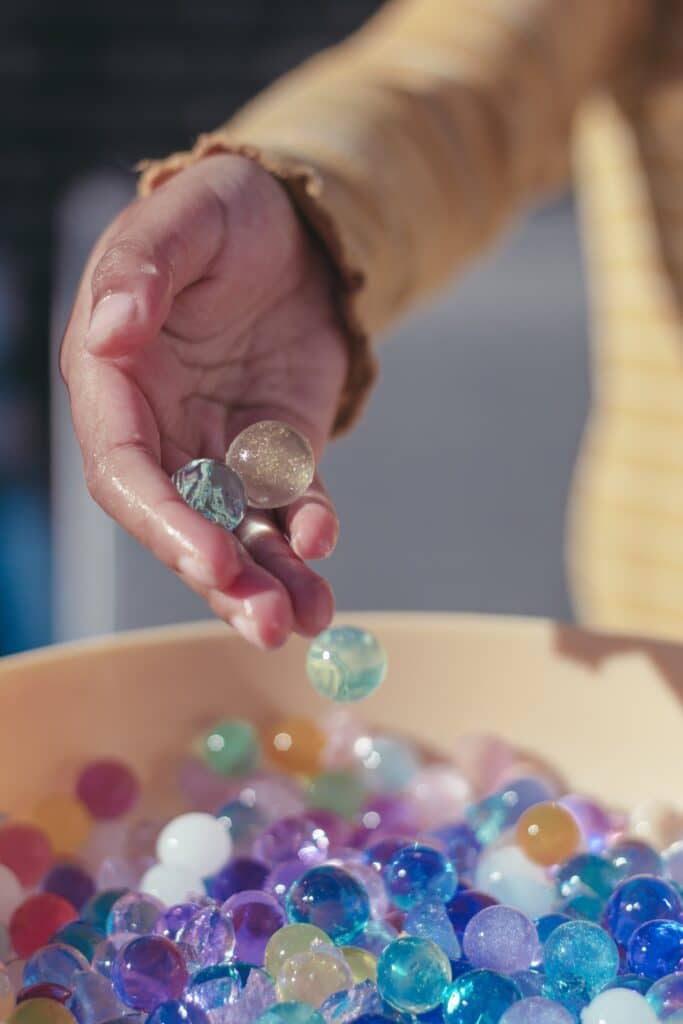What is a Sensory Bin?
Sensory bins are beneficial tools that provide children with the opportunity to learn and explore through tactile play. They can be made out of containers or tubs and are filled with specific items and materials that excite multiple senses at once. Sensory bins can be used as individual play to help a child become focused or during group play to allow children to help improve their social and play skills.
Benefits of Sensory Bins
Exploration Through Sensation
Sensory bins allow for exploratory play while exposing children to different types of textures, colors, odors and sounds all at once. Sensory bins can help introduce these unfamiliar textures and novel scents in a more calming and inviting way. Engaging in sensory play is a great way for children to process tactile input. Once an unfamiliar texture has been explored, children can work to develop a better understanding in order to prevent aversions from the different stimuli. Providing opportunities for sensory play is crucial for your child’s brain development. Sensory play helps to build and strengthen neural connections and pathways of the brain. It allows for more complex learning and supports fine motor skill development, language and cognitive development, social interaction and play skills.
Motor Skills
Sensory bins can improve your child’s developing motor skills through our tactile system, or sense of touch. This system helps to interpret the world around us and introduce new sensations through the use of our hands. Sensory bins provide the necessary tactile input to our hands to discriminate between different textures, consistencies and shapes.
The use of sensory bins can be important in facilitating grasp patterns that are important for pre-writing skills and manipulating utensils. Through acts of scooping, stirring, digging, grasping and pouring with a variety of tools, a child is able to increase hand/grip/pinch strength, precision,manipulation and improve hand-eye coordination.
Socialization and Play Skills
Sensory bins can help support your child’s growing social skills. They provide the opportunity to learn, listen, communicate and work together during play. They can also help foster your child’s imagination with the items provided in their bin. Tools such as shovels, spoons, measuring cups, tweezers, tongs and magnifying glasses can help facilitate pretend play in which a child can decide to take on the role of gardener, baker, chef, and detective etc.
Language and Cognitive Development
Sensory bins can help build and expand your child’s language skills through the act of identifying letters and naming shapes found inside of the bins. Items such as numbers, letters,
beads and buttons can be organized by colors, shapes and size to help them to recognize different characteristics and help strengthen and support their cognitive development. Through multisensory learning you can continue to increase your child’s level of skill retention and overall engagement.
How To Make A Sensory Bin Select A Theme
Select a theme for your child’s sensory bin that interests them! For example, if your child shows an interest in animals, some great ideas would be an animal farm or a marine life theme that can help teach them about different types of creatures.
Select A Container
For a small sensory bin, you can use tupperware containers, cardboard boxes, a small tool box or baking dishes. For larger sensory bins, you can use a plastic toy bin, storage containers, a medium sized fish tank or an unused litter box.
Select Materials
Some great ideas for base materials include:
-
● Rice
-
● Pasta
-
● Beans
-
● Coffee Grounds
-
● Shredded paper
-
● Easter grass
-
● Soil
-
● Sand
-
● Gel
-
● Shaving cream
-
● Buttons
-
● Beads
-
● Water Beads
-
● Stones
-
● Pom Poms
-
● Cotton Balls
-
● Foam shapes
-
● Letters
-
● Toys/ Figurines
-
● Leaves
-
● Pine Cones
Select Tools
Some great ideas for tools and instruments include:
-
● Toy Shovels
-
● Tweezers
-
● Spoons
-
● Measuring Cups
-
● Magnifying Glass
-
● Tongs
-
● Syringes
-
● Funnels
Tips To Remember
If your child is sensitive to certain textures and temperatures, try starting with “dry” materials such as rice, beans and sand rather than messy materials. This will help your child to become more comfortable playing with the different items found in their bin and help to facilitate both sensory and tactile stimulation at their comfort level. If you have assessed that your child is comfortable with dry materials, you can proceed to add “wet” items such as gel and shaving cream etc. These items provide a higher level of texture engagement and can vary in consistency and temperature. Always make sure you are continually assessing your child’s comfort levels with novel textures and are creating an enjoyable experience for them! It is important to follow your child’s lead and offer an “out” if the activity is found to be unpleasant for them. Make sure to keep wipes handy and/or have easy access to a sink for your child to be able to wash their hands. Some additional strategies to consider if your child is uncomfortable with these novel textures, is providing them with a utensil or brush to use instead of using their hands, this way they are still able to engage in this activity without getting their hands messy. As allows, consult with a pediatric occupational therapist if you have any questions or concerns regarding your child’s ability to process tactile or touch input.
Written by Melissa, OTS

